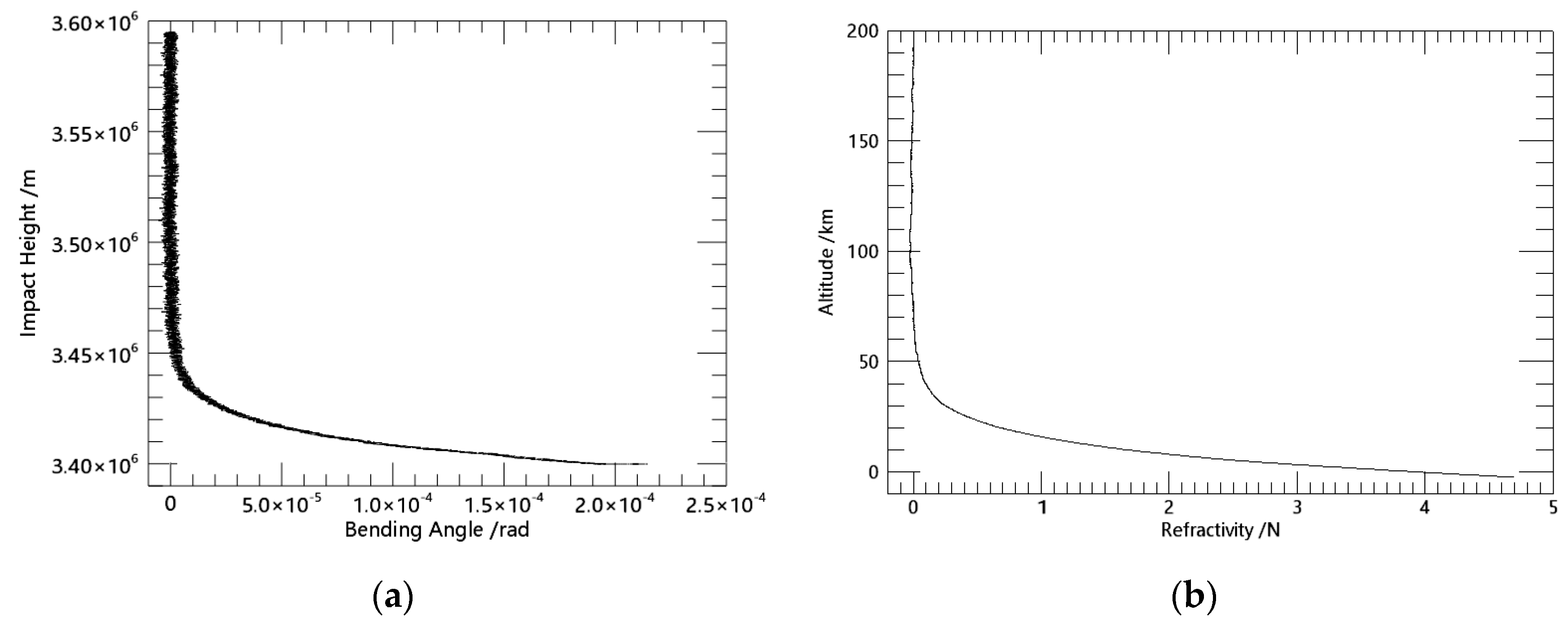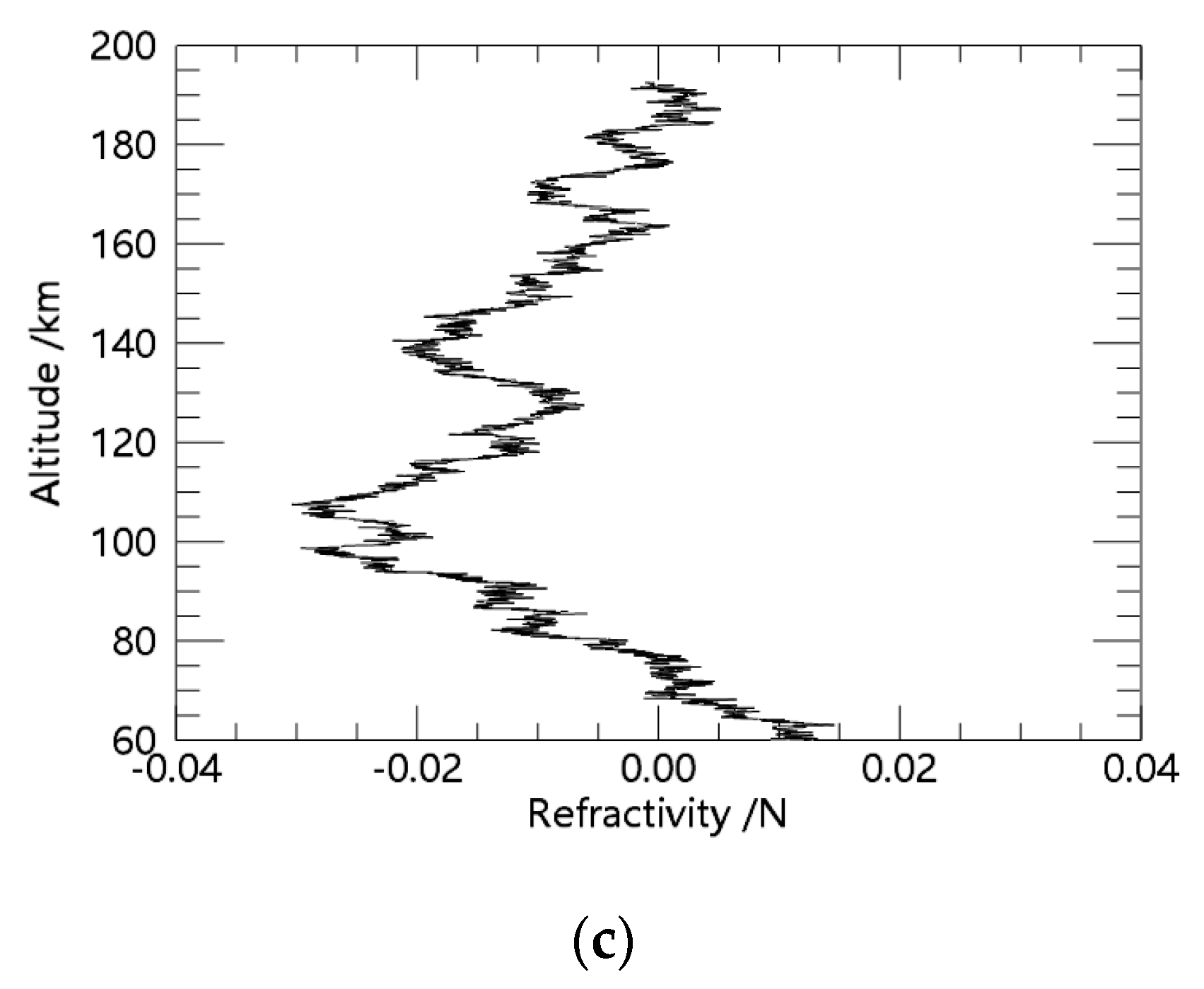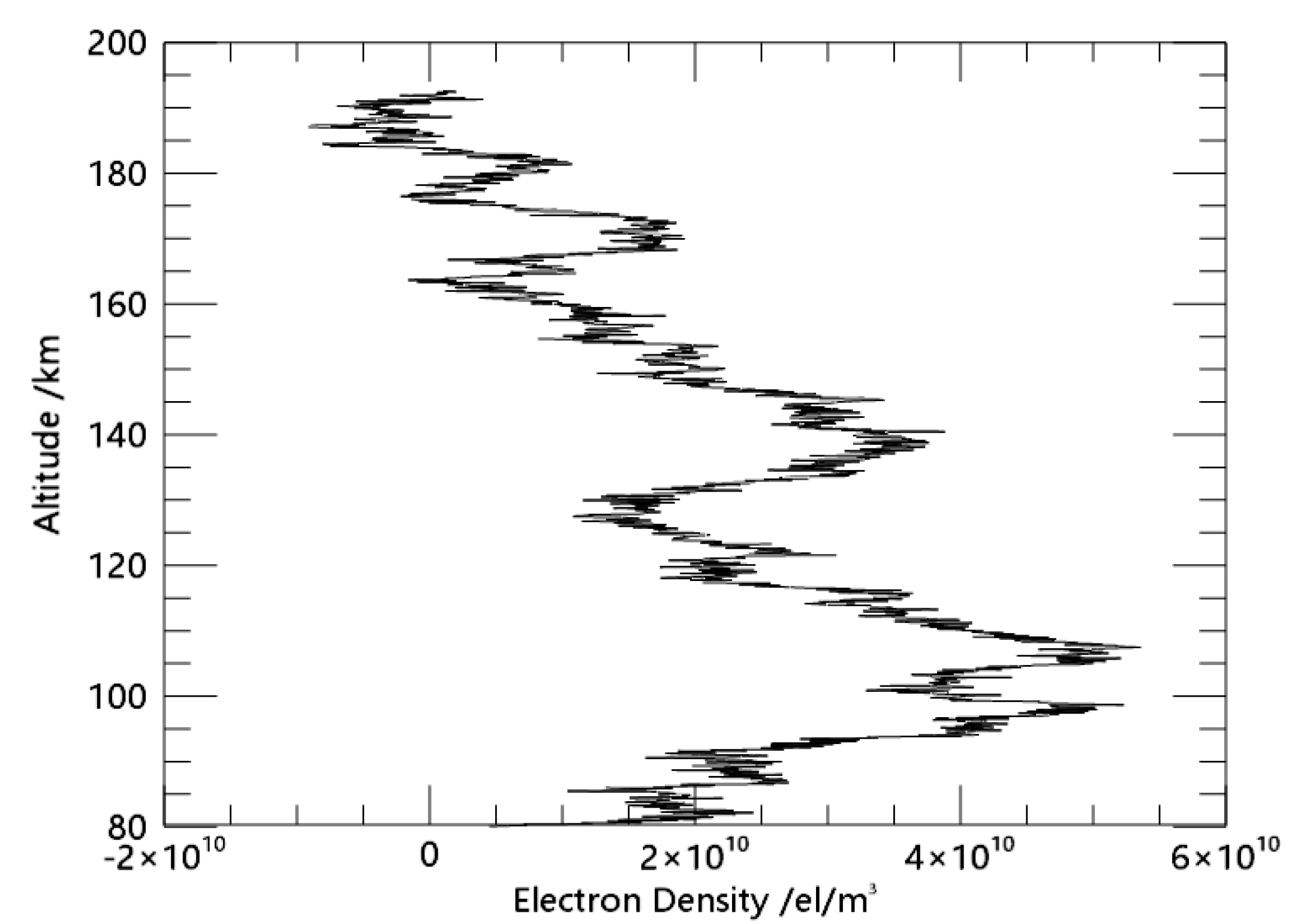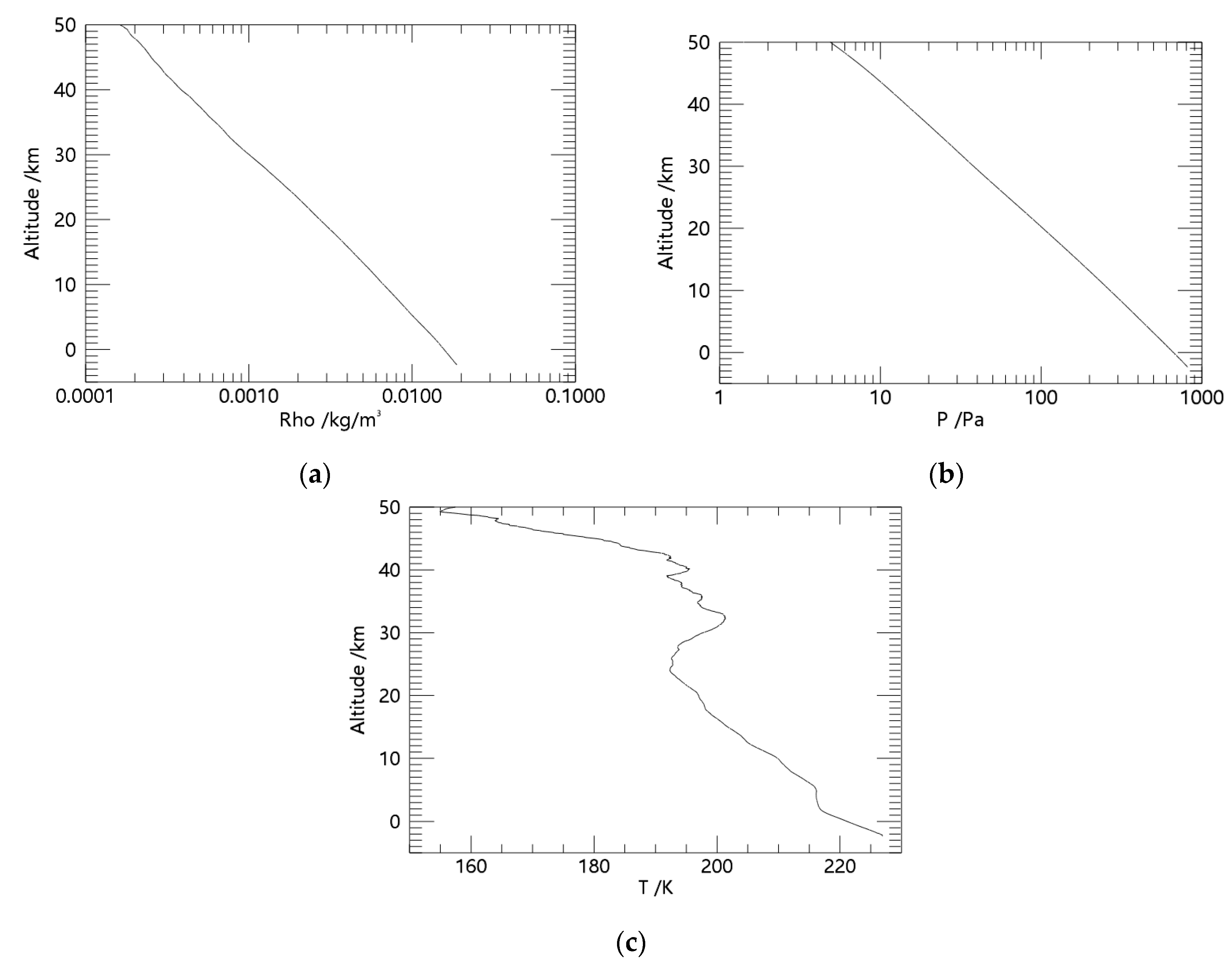First Observations of Mars Atmosphere and Ionosphere with Tianwen-1 Radio-Occultation Technique on 5 August 2021
Abstract
:1. Introduction
2. Tianwen-1 Radio-Occultation Technique and Data
2.1. One-Way Single-Frequency Radio Link between Tianwen-1 and Shanghai VLBI Ground Station
2.2. Obseved Quantaties
2.3. Excess Phase
2.4. Bending Angle and Refracticity
2.5. Electron Density
2.6. Neutral Density, Temperature and Pressure
2.7. Vertical Resolution
2.8. Data
3. Results
3.1. Signal Amplitude and Excess Doppler
3.2. Bending Angle and Refractivity Profiles
3.3. Mars Ionospheric Electron-Density Profile
3.4. Mars Atmospheric Profiles
4. Conclusions
Author Contributions
Funding
Data Availability Statement
Acknowledgments
Conflicts of Interest
References
- Withers, P. Prediction of uncertainties in atmospheric properties measured by radio occultation experiments. Adv. Space Res. 2010, 46, 58–73. [Google Scholar] [CrossRef]
- Hinson, D.P.; Asmar, S.W.; Kahan, D.S.; Akopian, V.; Haberle, R.M.; Spiga, A.; Schofield, J.T.; Kleinböhl, A.; Abdou, W.A.; Lewis, S.R.; et al. Initial results from radio occultation measurements with the Mars Reconnaissance Orbiter: A nocturnal mixed layer in the tropics and comparisons with polar profiles from the Mars Climate Sounder. Icarus 2014, 243, 91–103. [Google Scholar] [CrossRef]
- Ao, C.O.; Edwards, C.D.; Kahan, D.S.; Asmar, S.W.; Mannucci, A.J. A first demonstration of Mars crosslink occultation measurements. Radio Sci. 2015, 50, 997–1007. [Google Scholar] [CrossRef]
- Withers, P.; Felici, M.; Mendillo, M.; Moore, L.; Narvaez, C.; Vogt, M.F.; Oudrhiri, K.; Kahan, D.; Jakosky, B.M. The MAVEN Radio Occultation Science Experiment (ROSE). Space Sci. Rev. 2020, 261, 61. [Google Scholar] [CrossRef]
- Kliore, A.; Cain, D.L.; Levy, G.S.; Eshleman, V.R.; Fjeldbo, G.; Drake, F.D. Occultation experiment: Results of the first direct measurement of Mars’s atmosphere and ionosphere. Science 1965, 149, 1243–1248. [Google Scholar] [CrossRef]
- Zhang, R.Q.; Geng, H.; Sun, Z.Z.; Li, D.; Zhong, W.A.; Li, H.T.; Cui, X.F.; Liu, J.J. Technical innovations of the Tianwen-1 Mission. Acta Aeronaut. Astronaut. Sin. 2022, 43, 626689. (In Chinese) [Google Scholar] [CrossRef]
- Chen, L.; Zhao, C. China successfully launched its first Mars mission, Tianwen 1. Aerosp. China 2020, 21, 2. [Google Scholar]
- Pätzold, M.; Häusler, B.; Tyler, G.L.; Andert, T.; Asmar, S.W.; Bird, M.K.; Dehant, V.; Hinson, D.P.; Rosenblatt, P.; Simpson, R.A.; et al. Mars Express 10 years at Mars: Observations by the Mars Express Radio Science Experiment (MaRS). Planet. Space Sci. 2016, 127, 44–90. [Google Scholar] [CrossRef]
- Hu, X.; Wu, X.C.; Gong, X.Y.; Wang, X.; Xu, Q.C. Simulation of the Mars ionosphere radio occultation experiments. Acta Astromica Sin. 2009, 50, 301–311. [Google Scholar]
- Zhang, S.J.; Cui, J.; Guo, P.; Li, J.L.; Ping, J.S.; Jian, N.C.; Zhang, K.F. Martian electron density profiles retrieved from Mars Express dual-frequency radio occultation measurements. Adv. Space Res. 2015, 55, 2177–2189. [Google Scholar] [CrossRef]
- Withers, P.; Moore, L.; Cahoy, K.; Beerer, I. How to process radio occultation data: 1. From time series of frequency residuals to vertical profiles of atmospheric and ionospheric properties. Planet. Space Sci. 2014, 101, 77–88. [Google Scholar] [CrossRef] [Green Version]
- Liu, Q.H.; Huang, Y.; Shu, F.C.; Wang, G.; Zhang, J.; Chen, Z.; Li, P.; Ma, M.; Hong, X. VLBI technique for the orbit determination of Tianwen-1. Sci. Sin-Phys. Mech. Astron. 2022, 52, 239507. (In Chinese) [Google Scholar] [CrossRef]
- Zhou, W.L.; Song, S.L.; Li, P.J.; Zhang, Z.; Huang, C.; Huang, Y.; Wang, G. Ionsopheric TEC correction for VLBI based on GNSS density network. J. Deep Space Explor. 2020, 7, 362–370. (In Chinese) [Google Scholar]
- Standish, E.M. “JPL Planetary and Lunar Ephemerides,” DE405/LE405. Interoffice memorandum: JPL IOM 312. F–98-048, 26 August 1998. Available online: ftp://ssd.jpl.nasa.gov/pub/eph/planets/ioms/de405.iom.pdf (accessed on 17 February 2022).
- Zhu, J. The influence of gravitational deflection and retardation on VLBI time delay. Acta Astron. Sin. 1990, 31, 349–355. [Google Scholar]
- Yang, Z.G.; Zhao, M. Discussion and comparison of various VLBI relativistic time delay models. Acta Astron. Sin. 1992, 33, 201–211. [Google Scholar]
- Fjeldbo, G.; Eshleman, V.R. The Atmosphere of Mars Analyzed by Integral Inversion of the Mariner IV Occultation Data. Planet. Space Sci. 1968, 16, 1035–1059. [Google Scholar] [CrossRef]
- Hinson, D.P.; Simpson, R.A.; Twicken, J.D.; Tyler, G.L.; Flasar, F.M. Initial results from radio occultation measurements with Mars Global Surveyor. J. Geophys. Res. 1999, 104, 26997–27012. [Google Scholar] [CrossRef]
- Imamura, T.; Ando, H.; Tellmann, S.; Pätzold, M.; Häusler, B.; Yamazaki, A.; Sato, T.M.; Noguchi, K.; Futaana, Y.; Oschlisniok, J.; et al. Initial performance of the radio occultation experiment in the Venus orbiter mission Akatsuki. Earth Planet Space 2017, 69, 137. [Google Scholar] [CrossRef] [Green Version]
- Eshleman, V.R. The radio occultation method for the study of planetary atmospheres. Planet Space Sci. 1973, 21, 1521–1531. [Google Scholar] [CrossRef]
- Singh, R.N.; Prasad, R. Production of Dayside Ionosphere of Mars. J. Astrophys. Astron. 1983, 4, 261–269. [Google Scholar] [CrossRef]
- Martinis, C.R.; Wilson, J.K.; Mendillo, M.J. Modeling day-to-day ionospheric variability on Mars. J. Geophys. Res. 2003, 108, 1383. [Google Scholar] [CrossRef] [Green Version]
- Nagy, A.F.; Grebowsky, J.M. Current understanding of the aeronomy of Mars. Geosci. Lett. 2015, 2, 5. [Google Scholar] [CrossRef] [Green Version]
- Withers, P.; Felici, M.; Hensley, K.; Mendillo, M.; Barbinis, E.; Kahan, D.; Oudrhiri, K.; Girazian, Z. The ionosphere of Mars from solar minimum to solar maximum: Dayside electron densities from MAVEN and Mars Global Surveyor radio occultations. Icarus, 2021; in press. [Google Scholar] [CrossRef]
- Siddlea, A.G.; Mueller-Wodarga, I.C.F.; Stoneb, S.W.; Yelle, R.V. Global characteristics of gravity waves in the upper atmosphere of Mars as measured by MAVEN/NGIMS. Icarus 2019, 333, 12–21. [Google Scholar] [CrossRef]
- Hajj, G.A.; Kursinski, E.R.; Romans, L.J.; Bertiger, W.I.; Leroy, S.S. A technical description of atmospheric sounding by GPS occultation. J. Atmos. Sol.-Terr. Phys. 2002, 64, 451–469. [Google Scholar] [CrossRef]
- Hinson, D.P.; Tyler, D.; Lewisd, S.R.; Pätzold, M.; Tellmann, S.; Häusler, B.; Tyler, G.L. The martian daytime convective boundary layer: Results from radio occultation measurements and a mesoscale model. Icarus 2019, 326, 105–122. [Google Scholar] [CrossRef] [Green Version]
- Barth, C.A.; Hord, C.W.; Stewart, A.I.; Lane, A.L.; Dick, M.L.; Anderson, G.P. Mariner 9 Ultraviolet Spectrometer Experiment: Seasonal Variation of Ozone on Mars. Science 1973, 179, 795–796. [Google Scholar] [CrossRef] [PubMed] [Green Version]
- Krasnopolsky, V.A.; Parshev, V.A.; Krysko, A.A.; Rogachev, V.N. Structure of the Mars Lower and Middle Atmosphere Based on Mars 5 Ultraviolet Photometry Data; Academy of Sciences (USSR): Moscow, Russia, 1979. [Google Scholar]
- Encrenaz, T. The Atmosphere of Mars as constrained by remote sensing. Space Sci. Rev. 2001, 96, 411–424. [Google Scholar] [CrossRef]






Publisher’s Note: MDPI stays neutral with regard to jurisdictional claims in published maps and institutional affiliations. |
© 2022 by the authors. Licensee MDPI, Basel, Switzerland. This article is an open access article distributed under the terms and conditions of the Creative Commons Attribution (CC BY) license (https://creativecommons.org/licenses/by/4.0/).
Share and Cite
Hu, X.; Wu, X.; Song, S.; Ma, M.; Zhou, W.; Xu, Q.; Li, L.; Xiao, C.; Li, X.; Wang, C.; et al. First Observations of Mars Atmosphere and Ionosphere with Tianwen-1 Radio-Occultation Technique on 5 August 2021. Remote Sens. 2022, 14, 2718. https://doi.org/10.3390/rs14112718
Hu X, Wu X, Song S, Ma M, Zhou W, Xu Q, Li L, Xiao C, Li X, Wang C, et al. First Observations of Mars Atmosphere and Ionosphere with Tianwen-1 Radio-Occultation Technique on 5 August 2021. Remote Sensing. 2022; 14(11):2718. https://doi.org/10.3390/rs14112718
Chicago/Turabian StyleHu, Xiong, Xiaocheng Wu, Shuli Song, Maoli Ma, Weili Zhou, Qingchen Xu, Lei Li, Cunying Xiao, Xie Li, Chi Wang, and et al. 2022. "First Observations of Mars Atmosphere and Ionosphere with Tianwen-1 Radio-Occultation Technique on 5 August 2021" Remote Sensing 14, no. 11: 2718. https://doi.org/10.3390/rs14112718
APA StyleHu, X., Wu, X., Song, S., Ma, M., Zhou, W., Xu, Q., Li, L., Xiao, C., Li, X., Wang, C., Liu, Q., Chen, L., Chen, G., Cao, J., Wang, M., Li, P., Chu, Z., Xia, B., Yang, J., ... Li, Z. (2022). First Observations of Mars Atmosphere and Ionosphere with Tianwen-1 Radio-Occultation Technique on 5 August 2021. Remote Sensing, 14(11), 2718. https://doi.org/10.3390/rs14112718







